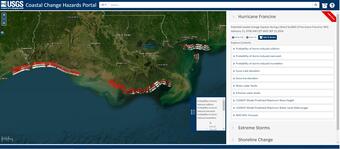Coastal Change Hazards Team Forecasted Hurricane Francine Beach Impacts
As Hurricane Francine approached the US Gulf of Mexico coast, the USGS Coastal Change Hazards team produced a series of forecasts for impacts on the beach. Forecasts were updated daily based on wave and storm surge forecasts from the National Oceanic and Atmospheric Administration (NOAA).
Prior to landfall on the Louisiana coast on September 11, 2024, the Coastal Change Hazards Team predicted that 63 percent of beaches from High Island, TX to the MS/AL border were very likely to erode at the dunes’ base, 49 percent of dunes were very likely to be overwashed by storm waves, and 15 percent of dunes were expected to be very likely to be inundated (completely submerged) by surge, tide, and waves given worst-case scenario surge and timing of the storm. In addition to special forecasts focused on impacts at the peak of the storm, real-time forecasts were being updated in the Total Water Level and Coastal Change Forecast Viewer. After landfall of a storm, the Coastal Change Hazards team uses NOAA imagery, USGS CoastCams, other beach cams, Digital Elevation Models (DEMs) constructed from post-storm aerial imagery and lidar data, and observations from USGS sensors to validate the predictions. The USGS Coastal Change Forecast model is used to estimate the impacts of elevated waves and storm surge along the coast due to extreme storms. This model has been in use since 2011 and is continually updated and improved.
Get Our News
These items are in the RSS feed format (Really Simple Syndication) based on categories such as topics, locations, and more. You can install and RSS reader browser extension, software, or use a third-party service to receive immediate news updates depending on the feed that you have added. If you click the feed links below, they may look strange because they are simply XML code. An RSS reader can easily read this code and push out a notification to you when something new is posted to our site.


